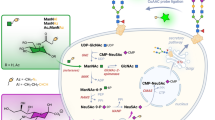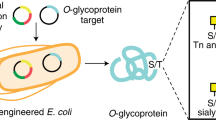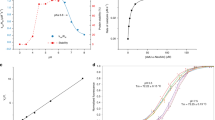Abstract
The sialic acid biosynthetic pathway in mammalian cells utilizes N-acetyl-D-mannosamine (ManNAc) as a natural metabolic precursor and has the remarkable ability to biosynthetically process non-natural ManNAc analogs. Herein, we describe a recipe-style protocol for the synthesis of the novel peracetylated analog Ac5ManNTGc (1) that contains a pendant acetylthio- group and enables incorporation of thiol functionalities into the glycocalyx of living cells. We also describe the synthesis of the oxygen analog Ac5ManNGc (2), which serves as an appropriate control compound for biological experiments with 1. Both 1 and 2 were prepared from a reported, common intermediate 8, which is selectively acetylated at the hydroxyl groups. In contrast to previous methods, this synthetic approach introduces O-acetyl groups first, followed by N-acylation. Starting from the commercially available D-mannosamine hydrochloride (5), gram quantities of both 1 and 2 can be prepared over five steps in about 2–3 weeks.
This is a preview of subscription content, access via your institution
Access options
Subscribe to this journal
Receive 12 print issues and online access
$259.00 per year
only $21.58 per issue
Buy this article
- Purchase on Springer Link
- Instant access to full article PDF
Prices may be subject to local taxes which are calculated during checkout


Similar content being viewed by others
References
Sampathkumar, S.-G., Li, A.V., Jones, M.B., Sun, Z. & Yarema, K.J. Metabolic installation of thiols into sialic acid modulates adhesion and stem cell biology. Nat. Chem. Biol. 2, 149–152 (2006).
Sampathkumar, S.-G., Jones, M.B. & Yarema, K.J. Metabolic expression of thiol-derivatized sialic acids on the cell surface and their quantitative estimation by flow cytometry. Nat. Protocols 1, 1840–1851 (2006).
Angelino, N.J., Bernacki, R.J., Sharma, M., Doson-Simmons, O. & Korytnyk, W. Versatile intermediates in the selective modification of the amino function of 2-amino-2-dexoy-D-mannopyranose and the 3-position of 2-acetamido-2-deoxy-D-mannose: potential membrane modification in neoplastic control. Carbohyd. Res. 276, 99–115 (1995).
Gooch, J. & Hawtrey, A.O. Synthesis of thiol-containing analogues of puromycin and a study of their interaction with N-acetylphenylalanyl-transfer ribonucleic acid on ribosomes to form thioesters. Biochem. J. 149, 209–220 (1975).
Collins, B.E., Fralich, T.J., Itonori, S., Ichikawa, Y. & Schnaar, R.L. Conversion of cellular sialic acid expression from N-acetyl- to N-glycolylneuraminic acid using a synthetic precursor, N-glycolylmannosamine pentaacetate: inhibition of myelin-associated glycoprotein binding to neural cells. Glycobiology 10, 11–20 (2000).
Jacobs, C.L. et al. Substrate specificity of the sialic acid biosynthetic pathway. Biochemistry 40, 12864–12874 (2001).
Saxon, E. et al. Investigating cellular metabolism of synthetic azidosugars with the Staudinger ligation. J. Am. Chem. Soc. 124, 14893–14902 (2002).
Luchansky, S.J. et al. Constructing azide-labeled cell surfaces using polysaccharide biosynthetic pathways. Methods Enzymol. 362, 249–272 (2003).
Keppler, O.T., Horstkorte, R., Pawlita, M., Schmidt, C. & Reutter, W. Biochemical engineering of the N-acyl side chain of sialic acid: biological implications. Glycobiology 11, 11R–18R (2001).
Kim, E.J. et al. Characterization of the metabolic flux and apoptotic effects of O-hydroxyl- and N-acetylmannosamine (ManNAc) analogs in Jurkat (human T-lymphoma-derived) cells. J. Biol. Chem. 279, 18342–18352 (2004).
Hinderlich, S., Oetke, C. & Pawlita, M. in Handbook of Carbohydrate Engineering (ed. Yarema, K.J.) Ch. 13, 387–405 (Francis & Taylor/CRC Press, Boca Raton, Florida, 2005).
Jacobs, C.L. et al. Metabolic labeling of glycoproteins with chemical tags through unnatural sialic acid biosynthesis. Methods Enzymol. 327, 260–275 (2000).
Biology and brimstone (editorial). Nat. Chem. Biol. 2, 169 (2006).
Villavicencio-Lorini, P., Laabs, S., Danker, K., Reutter, W. & Horstkorte, R. Biochemical engineering of the acyl side chain of sialic acids stimulates integrin-dependent adhesion of HL60 cells to fibronectin. J. Mol. Med. 80, 671–677 (2002).
Jones, M.B. et al. Characterization of the cellular uptake and metabolic conversion of acetylated N-acetylmannosamine (ManNAc) analogues to sialic acids. Biotechnol. Bioeng. 85, 394–405 (2004).
Sarkar, A.K., Fritz, T.A., Taylor, W.H. & Esko, J.D. Disaccharide uptake and priming in animal cells: inhibition of sialyl Lewis X by acetylated Gal β1,4GalcNAc β-O-naphthalenemethanol. Proc. Natl. Acad. Sci. USA 92, 3323–3327 (1995).
Fishman, P.H. & Brady, R.O. Biosynthesis and function of gangliosides. Science 194, 906–915 (1976).
Wang, Z., Sun, Z., Li, A.V. & Yarema, K.J. Roles for GNE outside of sialic acid biosynthesis: modulation of sialyltransferase and BiP expression, GM3 and GD3 biosynthesis, proliferation and apoptosis, and ERK1/2 phosphorylation. J. Biol. Chem. 281, 27016–27028 (2006).
Kim, E.J., Jones, M.B., Rhee, J.K., Sampathkumar, S.-G. & Yarema, K.J. Establishment of N-acetylmannosamine (ManNAc) analogue-resistant cell lines as improved hosts for sialic acid engineering applications. Biotechnol. Prog. 20, 1674–1682 (2004).
Menozzi, G. et al. Reaction of 2-dimethylaminomethylene-1,3-diones with nucleophiles. 13. 4H-Thieno[3,4-c]pyrazole derivatives with antiinflammatory, analgesic, antipyretic and platelet antiaggregating activities. Farmaco 47 (1992).
Harwood, L.M., Mooday, C.J. & Percy, J.M. Experimental Organic Chemistry: Standard and Microscale (Blackwell Science, Malden, MA, 1999).
Tanner, M.E. The enzymes of sialic acid biosynthesis. Bioorg. Chem. 33, 216–228 (2005).
Acknowledgements
We gratefully acknowledge the funding from the Whitaker Biomedical Engineering Institute, Arnold and Mabel Beckman Foundation, the National Institutes of Health (1R01CA112314-01A1) and the National Science Foundation (QSB-0425668).
Author information
Authors and Affiliations
Corresponding author
Ethics declarations
Competing interests
The authors declare no competing financial interests.
Rights and permissions
About this article
Cite this article
Sampathkumar, SG., Li, A. & Yarema, K. Synthesis of non-natural ManNAc analogs for the expression of thiols on cell-surface sialic acids. Nat Protoc 1, 2377–2385 (2006). https://doi.org/10.1038/nprot.2006.319
Published:
Issue Date:
DOI: https://doi.org/10.1038/nprot.2006.319
This article is cited by
-
Development of a novel method to evaluate sialylation of glycoproteins and analysis of gp96 sialylation in Hela, SW1990 and A549 cell lines
Biological Research (2015)
-
Cell surface glycoprotein profiling of cancer cells based on bioorthogonal chemistry
Analytical and Bioanalytical Chemistry (2012)
-
Metabolic expression of thiol-derivatized sialic acids on the cell surface and their quantitative estimation by flow cytometry
Nature Protocols (2006)
Comments
By submitting a comment you agree to abide by our Terms and Community Guidelines. If you find something abusive or that does not comply with our terms or guidelines please flag it as inappropriate.



